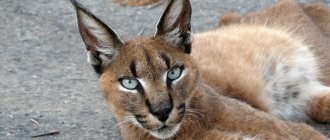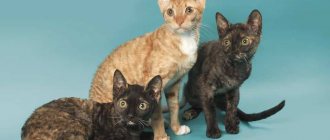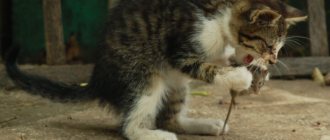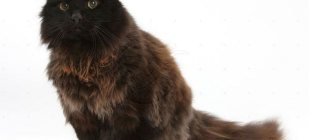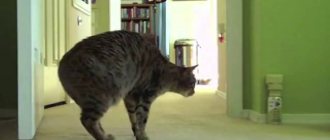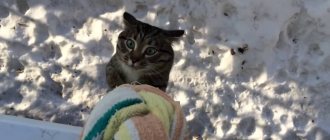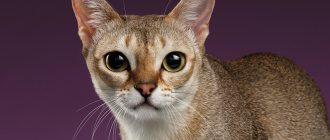Caracal
This beauty is kept at home
The average family does not keep caracals. The reason is the high cost of such a kitten: the cost starts at 450 thousand rubles.
Caracal is a native of Turkey. At least the country is considered the homeland of the animal. Over time, the wild cat spread to Africa, Arabia, India, etc.
Nowadays, wealthy people can afford to own a caracal. An animal with tassels on its ears requires space; representatives of the species are mobile, freedom-loving and very characteristic.
Externally, the caracal resembles a lynx: reddish coat color, rather long body, high ears with tassels. By the way, young animals have tassels that stand up, while older caracals droop and droop.
Breeders and owners of wild cats say that their pets are highly trainable, quickly get used to people and choose only one owner from all family members.
Rare animal - caracat
Caracat This rare breed is the result of crossing a caracal with a Bengal cat. These exotic animals were born due to Irina Nazarova, in whose nursery in the period 2013–2017. 2 generations of these cats were obtained. The low demand for caracats is associated not only with their recent appearance, but also with their fairly high cost, as well as the need to create special conditions for them.
You can see in the photo what this animal looks like with a strong body, long legs, a chic sandy or silver coat and ears with tassels, like a steppe lynx. Features of this breed:
- Large sizes. These cats grow up to 45 cm in height, their body length is about 90 cm. The weight of an adult is 15 kg.
- Energy.
- Expressed hunting instincts.
- Ability to jump to significant heights.
- Nocturnal lifestyle. This quality is not inherent in all individuals.
- High intellectual abilities.
- Affectionate, gentle, balanced disposition.
- Independence and stubbornness.
- Good health.
- Inability to eat dry food. It is recommended to feed such a pet with natural food.
- The need for a large area for living.
- The ability to get along in the same territory with other pets. At the same time, it is better to prevent the caraquet from coming into contact with rodents and birds.
- Lack of aggression. Despite this, it is better not to leave children alone with this pet.
Caraquet
Wild beauty, but domestic character
Please do not confuse caracal and caracat. The former are wild predators, the latter are crossbreeds between a caracal and an ordinary cat.
There are several versions of the origin of the breed. According to the first, Caraquets are an accidental breed from Russia. Allegedly, in the late 90s, a caracal cat living in the Moscow Zoo mated an ordinary cat who, God knows, looked into his enclosure. Murka gave birth to a baby who looked like her father: the same color, facial expression and tufts on the ears. It was with him that the creation of a new breed began.
The American version of the origin of the breed says: in 2005, a breeder of Abyssinian cats bred one of her pets to a caracal cat. The result was the Caraquet breed.
Caracat is a large animal with the appearance of wild ancestors. A distinctive feature of the breed is its huge eyes and ears, decorated with tassels. Despite the presence of caracals in the pedigree, the descendants turned out to be affectionate, attached to humans and very cute. Breeders say that the caracat is a cat with the habits of a dog.
Pixiebob
This breed is very unusual and extremely rare. It is compared to a small domestic lynx. Despite the fact that this breed is relatively young, its origins are shrouded in mystery. There are two versions of the appearance of these cats:
- Random matings of domestic cats with short-tailed forest cats that lived in North American and Canadian forests.
- Bred artificially by felinologists. Initially, it was conceived to be similar to the American lynx, an integral part of which are the tufts on the ears.
By the way, the absence of ear tufts leads to a significant decrease in points at cat shows. Another distinctive feature of pixiebobs is their short, flexible and thick tail, which was passed on to them at the genetic level.
[advertisement1]
These unusual cats have a dog-like, loyal nature, are easy to train, and are devoted to one person in the family. These are very talkative animals, their meowing is very reminiscent of birds chirping. And they simply need company with humans, otherwise they can quickly go wild.
Maine Coon
One of the largest breeds in the world
The breed is one of the largest in the world. It is not surprising, since the weight of an adult cat reaches 15 kg, and in combination with fluffy hair, tufts on the ears and a “brutal” facial expression, Maine Coons make an indelible impression.
Anyone who keeps representatives of this breed will not let you lie: “coons” are gorgeous! And we are not talking about the appearance of these animals at all, they also have an excellent character. With members of the family in which Maine Coons live, they are affectionate and talkative. Strangers are such an irritant; cats are wary of strangers. If a stranger who comes to the house for the first time decides to fraternize with its four-legged inhabitant, he risks getting a clawed paw on the hand, being scolded in cat language, or being bitten.
Siberian beauties
Siberian cat This is one of the most popular cat breeds in Russia. She gained popularity due to the following qualities:
- Gorgeous thick fur.
- High intelligence.
- Balance that hides confidence and strength.
- Delicacy, sensitivity, tenderness, independence.
- Playfulness.
- Incredible devotion.
- Quite compact sizes, thanks to which the Siberian cat is suitable for keeping in a small apartment and a spacious private house.
- Long life expectancy. On average, representatives of this breed live about 17–20 years.
- Excellent health.
- Energy.
- Friendliness. Despite their friendly disposition, these cats are quite suspicious of strangers.
- Unobtrusiveness. Such a pet will never follow the owner's heels.
- The ability to get along in the same territory with other animals. This quality does not prevent the “Siberians” from repelling their fellow aggressors.
- Cleanliness. These animals keep their coats clean, but this does not eliminate the need for additional care.
- Wide variety of colors.
- Taciturnity.
- Undemanding to living conditions.
- Pronounced hunting qualities. This four-legged hunter will rid the house of rodents.
The disadvantages of this breed include:
- susceptibility to mood swings;
- a strong sense of self-esteem;
- love of heights;
- need for increased physical activity.
Short-tailed elf (Pixie-bob)
Terrible but cute elf
A hybrid of a forest cat and a domestic cat, the first mention of the breed appeared in the 80s of the last century in the USA. The breed was named after the first short-tailed kitten born as a result of mating a wild forest cat and an ordinary cat. The baby was named Pixie, which means “Elf”.
Elves look menacing: large body and head, frowning eyes, tufts on their ears - all this makes them look like their wild ancestors. In fact, pixie bobs are the kindest and most gentle creatures. Cats of this breed are much more attached to their owner than to other family members.
The peculiarity of the animals is not only their unusual exterior, but also the presence of extra toes on their paws. It is also extremely difficult for elves to get along with other cats, so it is recommended to have representatives of the breed as the only pet in the family.
Cat breeds with ear tufts
Modern breeds of cats with tufts at the ends of their ears include only a few cats. By the way, in some cases, Neva masquerade cats can also “acquire” tassels on their ears. Thus, the appearance of this kind of “decoration” is associated with the manifesting signs of wild ancestors. The tassels are hardly noticeable, but stick straight up. Due to the fact that this trait is not inherited, but is “random,” masquerade cats are not included in our list.
Maine Coon
Maine Coons are one of the largest domestic cat breeds. Originally bred in the United States, Maine Coons are considered descendants of the Maine cats of Northeastern America. The breed was recognized in 1982.
Males can weigh up to 8.2 kg, females are slightly lighter - up to 5.4 kg. The largest cats can grow up to 41 centimeters at the withers. In this case, the total length of the body with the tail can be up to 12 centimeters (the length of the tail is no more than 36 centimeters). That is, Maine Coons are similar in size to a medium-sized dog.
Both male and female cats have ear tufts from birth. The coat color can be almost any color, since as a result of selection, kittens of a wide variety of colors appeared. The breed has very thick hair, which is typical for all mammals whose historical habitat is the northern countries. Maine Coons live up to 12–15 years.
Maine Coons need a good diet rich in protein and nutrients. Mobility and playfulness are the main qualities of the breed, so the owner must provide the cats not only with space to play and a variety of toys, but also with adequate nutrition. If you use natural food, then lean meat should make up 70% of your pet’s diet, and the remaining 30% should be boiled eggs, milk porridge, and sea fish. However, breeders also trust special cat food.
Despite their large size and unusual weight for cats, Maine Coons are very affectionate creatures, quickly become attached to their owner and behave in the same way as ordinary representatives of the cat family: they purr, lie on their laps and require affection.
Prices for a Maine Coon kitten in nurseries vary from 20 to 50 thousand rubles.
The large Maine Coon cat has a dog-like character and loyalty.
Siberian cat
For the first time, they began to write about cats resembling modern Siberian ones in sources of the 16th century. At that time, the animals were called Bukhara, cats lived mainly in Siberian forests, but occasionally they were seen in different parts of the Russian Empire.
The modern Siberian cat is a semi-longhaired breed: the standard was determined in 1997. Thick fur protected the animals’ ancestors from severe frosts in Siberia and became the main feature of the furry beauties. The breed can have a wide variety of colors, but it is mandatory to have a powerful fluffy tail and tufts on the ears.
The Siberian cat is a very large animal. Males can weigh up to 9 kilograms, cats - up to 7. Harsh living conditions affected the period of puberty - Siberians are ready to procreate no earlier than the age of five. Moreover, the average life expectancy of cats is about 15 years.
The character of Siberians is soft and pliable. However, cats will never bother their owner: any object in the apartment can become an excellent toy for them. Animals love heights, so they can often rest or sleep on kitchen shelves or cabinets.
Kittens are priced relatively inexpensively - from 5 thousand rubles per individual.
The tassels on the ears of a Siberian cat are not as pronounced as those of a Maine Coon, although the breeds are related
Chausie
Felinologists recognized this breed only in 2003. The ancestors of the Chausie are considered to be the Abyssinian cat and the wild jungle cat. Although there is a theory that says that the Chausie is one of the most ancient cat breeds, since the image of the ancient Egyptian goddess Bast is very reminiscent of the Chausie.
Cats of this breed are quite large: about 40 centimeters in height and very heavy. For example, an adult sexually mature cat can weigh 15 kilograms, female cats are slightly smaller - 10–12 kilograms.
The Chausie's coat is very short but thick. Moreover, the breed has only three types of color:
- black;
- ticked silver;
- ticked tabby.
And the tip of the tail and tassels on the ears for any type of color should be black. A pattern should be visible on the skin - maybe not clear, but certainly not blurry. A sign of the breed is a black “necklace” on the neck.
The character of the chausie combines two extremes: on the one hand, it is an affectionate and sweet animal, on the other, it is a predator. Therefore, it is unlikely that you will be able to completely subjugate your pet to your rules.
The breed can be considered expensive in every sense - kittens cost at least 200 thousand rubles, the cost of individual specimens can reach 1 million rubles. At the same time, animals have very weak digestion and an insatiable appetite, and they need a lot of space to play. It is important that Chausie males are sterile until the third generation. The lifespan of a pet is 15–20 years.
Chausies are sometimes called "Chausies" or "Nile cats" because they were bred in Egypt.
Pixiebob
The Pixiebob breed is the result of selective breeding work. Geneticists wanted to create a new breed that would resemble a lynx in appearance. However, it was not until the 1980s that the experiments were successful. And the first cat was named Pixie, which means “elf,” because of the long tufts at the ends of its ears. Today this breed is recognized by most felinological systems.
The pixie bob has a short tail (up to 3 centimeters) and a massive large body. Cats weigh 3–6 kilograms, males can reach 8 kilograms in weight. The main feature of the breed is that individuals can have six toes on their paws and this is not considered a disqualifying feature.
The main difference of the breed is considered to be its “animal” look - that is, deep-set eyes and a very powerful chin. However, despite their rather frightening appearance, these cats are very affectionate and obedient, and in character they are more reminiscent of dogs. They like to play with people and accompany them everywhere: pixiebobs are usually considered very loyal pets.
The coat color of the pixie bob is strictly standardized:
- Mouse-colored Brown Spotted Tabby shades only;
- intense ticking.
Today we can distinguish short-haired and long-haired representatives of the breed. Breeders sell kittens for 30 - 50 thousand rubles and more.
A large imposing cat loves to have a small funny tail
Norwegian Forest Cat
The breed is common in European countries, most often in Norway. It was recognized as a separate cat breed in 1977. A unique characteristic of all Norwegians is the ability to climb down from a tree upside down, which they acquired in the process of adapting to new natural conditions.
Kitties usually weigh 5–5.5 kilograms, while male cats gain weight up to 8–9 kilograms.
The Norwegian Forest Cat has a very long fluffy tail. Typically, the length of the tail corresponds to the length of the animal's body. Cats have very thick fur. The breed has a so-called “triple” base coat, that is, the coat itself, the undercoat and the outer hairs. The large ears have cute tassels. The color can be any, with the exception of color point. In this case, a sign of the breed is considered to be the coincidence of the color of the fur with the color of the eyes.
The breed is considered very docile and peaceful. Cats love to purr and lie next to their owner. It should be noted that Norwegians remain playful throughout their entire life, that is, up to 10–14 years.
The cost of a kitten is from 2 to 25 thousand rubles, depending on the pedigree and external data.
The tassels on the ears of the Norwegian forest cat are large and expressive.
Norwegian Forest Cat
Feline perfection
A beauty originally from the Norwegian forests, who miraculously became an ordinary cat. According to ancient legend, guardians lived in the forests of Norway. No one had ever seen them, because the guardians moved between the trees at the speed of light. One day one of the guardians of the forest hesitated and his large, fluffy tail flashed between the trees. People saw this and immediately began vigorous activity to capture the forest guardian.
The guardians turned out to be beautiful cats. Huge, fluffy, with expressive eyes and tufts on the ears. The animals, at first, resisted, completely unwilling to be tamed. But time passed, cats learned to trust people, and the latter declared forest guardians as a new breed. This is how the Norwegian Forest Cat appeared.
Representatives of the breed are large (up to 9 kg), energetic and self-sufficient. Being hunters by nature, “Norwegians” do not get along well with other domestic animals. Especially with birds and rodents. Small breeds of dogs are regarded by Norwegian forest cats as a misunderstanding, not worthy of attention. Forest beauties tolerate their own kind, but with difficulty. It is better to have a Norwegian Forest Cat as your only pet.
History of breeding cats with ear tufts
If you look closely at cats of long-haired breeds, you will notice that almost all of them have small tassels at the ends of their ears. Although many cats have tassels that disappear as they grow older. However, there are several officially recognized breeds for which tassels are standard.
It is still not known exactly why cats need such decoration as tassels. There are three theories on this matter:
- The tassels on the ears are like sound amplifiers. They help the animal not only amplify weak sounds, but also accurately determine the source of the noise. It is thanks to their tassels that wild cats have become such professional hunters: after all, they can hear even the faint rustling of mice under the snow. However, this theory has been questioned many times, since the hairs on the tips of the ears are in no way connected with the cat's senses.
- Another version says that the tuft of hair on the ears is a kind of beacon, thanks to which animals see each other at a great distance. For example, a lynx naturally has excellent eyesight, and an original decoration helps a wild cat notice its brethren from afar, even in the densest forest.
- The latest theory is that tassels are a parameter that determines the age of a cat. That is, the longer and darker the hairs on the tips of the ears, the more mature and experienced the cat. But even forest lynx at an advanced age can have a light shade of tassels, so few people consider this theory seriously.
It is quite possible that the tassels serve as sound locators, because cats immediately react to sound by raising their ears to their maximum height
However, many breeders of cats with tassels on their ears are interested in the question: when did the very first cat appear that had such an unusual “decoration”? All currently recognized breeds have their own history, but officially the Norwegian Forest Cat can be considered one of the “oldest” cat breeds with tufted ears.
Official sources begin to mention the Norwegian forest cat from the 16th century. By the way, it is quite possible that it was she who became the ancestor of modern Maine Coons. However, illustrations of ancient Scandinavian culture clearly show that the Norwegians accompanied the Vikings long before the 16th century. For example, some legends and sagas say that the god Thor was always accompanied on his travels by a “fluffy forest beauty,” whose descriptions are very similar to the characteristics of a modern Norwegian cat.
Therefore, if you believe the Scandinavian sagas, the first representative of cats with tufts on their ears can be considered the Norwegian forest cat. It was she who became the progenitor of many existing breeds with tassels.
If Thor traveled on land in a chariot, then on sea voyages on a ship he was always accompanied by a fluffy cat
Mr. Cat recommends: the best breeds
Below are the most striking representatives among felines with tassels.
Caraquet
This hybrid breed was bred at the Moscow Zoo in 1998 completely by accident, by crossing an ordinary cat and a caracal.
The caracat has a brownish-red coat color; an adult cat reaches almost 1 meter in length (including the tail). They also have long large paws, a small head compared to the body, large mobile ears with characteristic tassels.
Although this breed looks like a wild animal, the cat’s character is quite friendly and affectionate. Such a cat is in dire need of constant movement, so if you decide to have this handsome cat at home, you need to make sure there is enough space for him.
In addition, the caraqueta, like a dog, must be walked on a special leash-vest.
Kittens need to be bathed no more than once every three months, and adult cats - when dirty. It is necessary to ensure that a caracat with wet fur does not fall into a draft, otherwise there is a high risk of catching a cold.
Combing occurs 1-2 times a week, and in the summer during the molting period it should be done more often, preferably every day.
Food: raw meat (beef, poultry, rabbit, fish). Clean water should always be freely available to your cat.
You cannot give pork, cooked meat, or table food.
Maine Coon
This breed was obtained through natural hybridization in the USA more than a century ago.
Maine Coons are considered giants among cats. They have a good, strong body, wide bones and a massive muzzle. An adult cat can reach a weight of 15 kg (a male in rare cases can weigh up to 15 kg, the usual weight is 5-8 kg) and in isolated cases grows up to 1 meter in length. The coat is long and fluffy and comes in a variety of colors.
These cats are real good-natured people, but incorrigible lazy people. Maine Coons love to climb somewhere high and watch the bustle of the world from there. This breed is very attached to its owner, and it also differs from other cats in its “talkativeness” - cats make sounds that can be heard as unintelligible speech, and it seems as if they are trying to tell something.
Wool is the first thing the owner will have to take care of. The cat needs to be brushed daily.
These good-natured creatures bathe with great pleasure, but it is better not to arrange “bath procedures” too often, but to wash only when it is necessary to maintain hygiene.
Maine Coons are susceptible to developing periodontal disease, so do not forget about the cat’s oral cavity and buy special food to strengthen teeth.
They enjoy eating raw beef and boiled poultry meat, quail eggs and cottage cheese.
Pixie Bob
In the second half of the 20th century in the United States, breeders specifically tried to develop a cat breed that looked like a lynx, but with a short tail. Until the 80s, these experiments were inconclusive, until the work finally paid off. An individual was born, a cross between a domestic cat and a short-tailed forest cat.
They decided to name the breed “Pixie-Bob” (translated from English as “short-tailed elf”).
It has a stocky body, a large head and an animal look (due to deep-set eyes, looming, evil-looking eyebrows and a massive chin), a reddish fur coat with black spots, and a short thick tail. This breed is prone to an abnormality called polydactyly (extra toes). The ears are round and small; they do not always have tassels.
Short-tailed animals are quite friendly with people, but only one person is recognized as the owner - the one who feeds them.
Pixie Bob is an active breed that loves to play, but it is not recommended to have these animals in a house where other animals already live, otherwise there is a high risk of witnessing constant conflicts and merciless fights.
Due to his mobility, Pixie-Bob loves to walk in the fresh air, but it is better under the supervision of his owner, because. If a cat gets lost, it will go wild and is unlikely to ever approach a person again.
You need to comb the coat once a week, more often in the summer.
Cats of this breed are not picky eaters; they eat dry and wet food from the store with appetite. But if the owner decides to switch Pixie-Bob to natural food, then the cat should receive fresh meat every day.
Norwegian Forest Cat
As you can guess from the name of the breed, the homeland of these fluffy beauties is Norway. It has existed as a separate cat breed since the 70s.
An adult animal weighs about 8 kg. It is distinguished by long hair of white, black, red and gray colors. The Norwegian cat has a powerful skeleton, dense body, large paws, long whiskers and a bushy tail.
Norwegians are affectionate but energetic cats. By their “forest” nature they are hunters, so small animals and birds (hamsters, rats, chinchillas, canaries, etc.) will be in great danger around them. Despite their good-natured disposition, these cats do not allow themselves to be squeezed, especially by small children, who sometimes cannot control their strength.
The wayward Norwegian will allow himself to be stroked only when he wants it. If this cat doesn’t like the way its owners treat it, it will run away from home without a second thought and never return.
The breed is considered a record holder for life expectancy. With proper nutrition and proper care, this cat will be with its owners from 10 to 14 years, some can live up to 18 years.
Cats are also distinguished by their endurance, strength and immunity. The main thing for the owners of these “forest” animals is not to forget to brush their pets more often, get vaccinations in a timely manner and give the cat the opportunity to roam freely.
Norwegians are not afraid of even extreme cold; they feel comfortable at low temperatures.
Unlike Maine Coons, Norwegian Forest cats are “silent”; they will only give voice if there is an urgent need for it.
When it comes to food, the Norwegian breed is completely unpretentious, but the memory of wild ancestors still makes itself felt - the favorite food of forest cats remains finely chopped poultry or fish (always raw).
To prevent the cat from becoming infected with worms from raw meat, it is kept in the freezer for several days and only then, after defrosting, is it given to the animal to feast on.
Siberian cat
Representatives of this breed are semi-longhaired cats. For the first time, the “Siberian” became known in the 16th century, when these cats lived everywhere on the territory of the Russian Empire. Like any animal now considered domestic, the Siberian cat led a wild lifestyle until it was tamed.
They have a large and developed body, strong but not long legs. Females reach a weight of up to 6 kg, and males can be twice as large - up to 12 kg.
A distinctive feature of the Siberian is considered to be a rich fluffy collar around the neck and fur “pants” on the hind legs.
Their saliva contains less protein than other breeds, so this breed can be recommended for people prone to allergies.
A true “Siberian” has a calm disposition and a peaceful character. She gets along well with children, willingly cuddles up to people and is very attached to her owner.
There are many stories where representatives of this particular breed saved the lives of their owners during fires, gas leaks, etc.
Like Norwegian cats, Siberians are wonderful hunters. Living in rural areas near bodies of water, they love to go fishing or catch birds and rodents.
The Siberian cat is considered one of those breeds that live a long time, naturally, with high-quality and varied nutrition and care. Due to its endurance, the “Siberian” can rarely be affected by any illness. However, owners should carefully monitor cats to prevent urolithiasis.
Also, like all furry animals, Siberian cats are prone to clogging their intestines with hair, so it is important to comb out excess hair as often as possible during shedding and give special pastes to remove clumps.
Many owners suffer from high activity and playfulness of their pets, especially at night. The reason for this behavior lies on the surface - the cat is bored, it needs human attention and a variety of toys with which to occupy itself.
Usually, the owners of the Siberian cat do not have problems with feeding. The “Siberian” itself is omnivorous and unpretentious in food; its nature dictates that it eats natural food, i.e. meat, fish, eggs, etc.
Not allowed: fried and smoked. It is also worth considering that the Siberian cat has an unlimited appetite, she can eat often and a lot, so the main thing here is not to overfeed, so as not to have problems with weight.
Heavy weight, as you know, greatly shortens the life of a furry pet.
Chausie or Nile
This breed appeared as a result of an artificial combination of the gene of a domestic Abyssinian cat and a jungle cat in the 90s of the last century.
Chausie's fur is thick, but short, and has a silver-brown, gold or black color. The attribute of this breed is tufts on large ears (but not always) and a long black tail.
Chausies are incredibly inquisitive, active and loving pets. They can be housed next to other animals without any fear; this breed is completely non-conflicting. Cats need space, so cramped apartments are not suitable for these freedom-loving cats.
They quickly become attached to their owner, but do not like “calf tenderness”; by nature they are independent and are accustomed to expressing affection towards a person in their own way.
In terms of care, Chausie is completely unpretentious. Any conscientious owner can handle these cats. Taking care of your pet is standard: wash it when it gets dirty, clean its eyes, take care of its ears.
This breed is not considered sickly and picky, thanks to its wild feline ancestors, Chausie can boast of excellent health and strong immunity.
The only thing this cat desperately needs is a large space where it can run around to its heart's content.
Unpretentiousness in food is one of the main characteristics of Chausie. But the cat owner himself must understand that balanced and high-quality nutrition is the key to health for the four-legged family member. Therefore, dry food is an acceptable, but not the best option for nutrition. It is better to feed your hybrid cat raw poultry.
These are the most striking representatives of the cat family, with wild, but at the same time cute tufts on their ears. All varieties are beautiful and interesting in their own way, each has its own advantages, but the main thing for every pet is the care and love of the owner.
